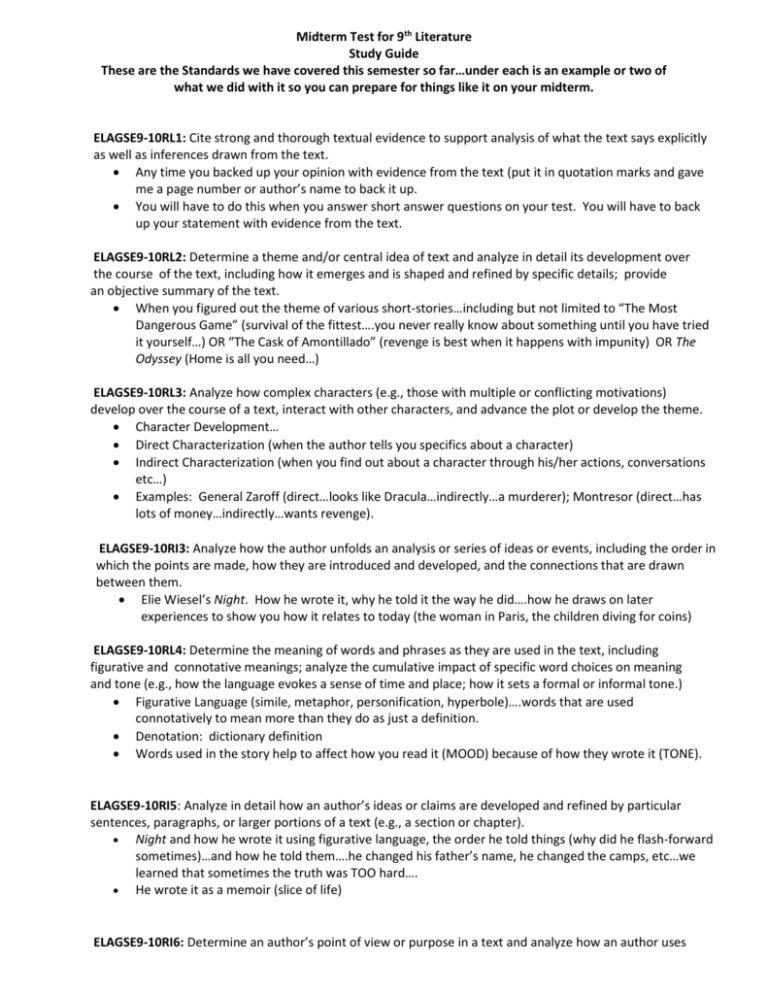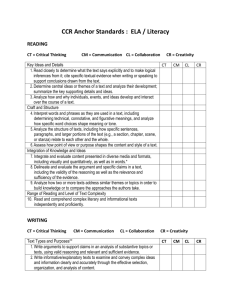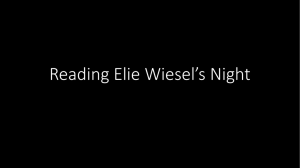Midterm Test Study Guide - Social Circle City Schools
advertisement

Midterm Test for 9th Literature Study Guide These are the Standards we have covered this semester so far…under each is an example or two of what we did with it so you can prepare for things like it on your midterm. ELAGSE9-10RL1: Cite strong and thorough textual evidence to support analysis of what the text says explicitly as well as inferences drawn from the text. Any time you backed up your opinion with evidence from the text (put it in quotation marks and gave me a page number or author’s name to back it up. You will have to do this when you answer short answer questions on your test. You will have to back up your statement with evidence from the text. ELAGSE9-10RL2: Determine a theme and/or central idea of text and analyze in detail its development over the course of the text, including how it emerges and is shaped and refined by specific details; provide an objective summary of the text. When you figured out the theme of various short-stories…including but not limited to “The Most Dangerous Game” (survival of the fittest….you never really know about something until you have tried it yourself…) OR “The Cask of Amontillado” (revenge is best when it happens with impunity) OR The Odyssey (Home is all you need…) ELAGSE9-10RL3: Analyze how complex characters (e.g., those with multiple or conflicting motivations) develop over the course of a text, interact with other characters, and advance the plot or develop the theme. Character Development… Direct Characterization (when the author tells you specifics about a character) Indirect Characterization (when you find out about a character through his/her actions, conversations etc…) Examples: General Zaroff (direct…looks like Dracula…indirectly…a murderer); Montresor (direct…has lots of money…indirectly…wants revenge). ELAGSE9-10RI3: Analyze how the author unfolds an analysis or series of ideas or events, including the order in which the points are made, how they are introduced and developed, and the connections that are drawn between them. Elie Wiesel’s Night. How he wrote it, why he told it the way he did….how he draws on later experiences to show you how it relates to today (the woman in Paris, the children diving for coins) ELAGSE9-10RL4: Determine the meaning of words and phrases as they are used in the text, including figurative and connotative meanings; analyze the cumulative impact of specific word choices on meaning and tone (e.g., how the language evokes a sense of time and place; how it sets a formal or informal tone.) Figurative Language (simile, metaphor, personification, hyperbole)….words that are used connotatively to mean more than they do as just a definition. Denotation: dictionary definition Words used in the story help to affect how you read it (MOOD) because of how they wrote it (TONE). ELAGSE9-10RI5: Analyze in detail how an author’s ideas or claims are developed and refined by particular sentences, paragraphs, or larger portions of a text (e.g., a section or chapter). Night and how he wrote it using figurative language, the order he told things (why did he flash-forward sometimes)…and how he told them….he changed his father’s name, he changed the camps, etc…we learned that sometimes the truth was TOO hard…. He wrote it as a memoir (slice of life) ELAGSE9-10RI6: Determine an author’s point of view or purpose in a text and analyze how an author uses rhetoric to advance that point of view or purpose. Why did Elie Wiesel write Night. Why did he use figurative language to help tell his story? Why did he continuously tell of people and what they saw? ELAGSE9-10RL6: Analyze a particular point of view or cultural experience reflected in a work of literature from outside the United States, drawing on a wide reading of world literature. The Odyssey and all of its Greek traditions, ideas, characters etc….the idea that we get our Southern Hospitality from Greek traditions. The idea that we get our symbols from Greek gods/goddesses. The fact that most of our prefixes and suffixes came from the Greek language. ELAGSE9-10RI7: Analyze various accounts of a subject told in different mediums (e.g., a person’s life story in print and multimedia), determining which details are emphasized in each account. Night vs. “Band of Brothers” Night vs. “Schindler’s List” Night vs. Documentary of Auschwitz Night vs. pictures/propaganda (bulletin board) ELAGSE9-10W1: Write arguments to support claims in an analysis of substantive topics or texts, using valid reasoning and relevant and sufficient evidence. You believe that Elie Wiesel is not a fraud…. You can argue that the Holocaust was an atrocity and history should never repeat itself. You can argue that Brother is/is not responsible for Doodle’s death. ELAGSE9-10W2: Write informative/explanatory texts to examine and convey complex ideas, concepts, and information clearly and accurately through the effective selection, organization, and analysis of content. a. Introduce a topic; organize complex ideas, concepts, and information to make important connections and distinctions; include formatting (e.g., headings), graphics (e.g., figures, tables), and multimedia when useful to aiding comprehension. b. Develop the topic with well-chosen, relevant, and sufficient facts, extended definitions, concrete details, quotations, or other information and examples appropriate to the audience’s knowledge of the topic. Your Greek Mythology Project Your book reviews Why Odysseus is the Epic Hero etc… ELAGSE9-10W3: Write narratives to develop real or imagined experiences or events using effective technique, well-chosen details, and well-structured event sequences. Ending to “The Interlopers” Another daydream for Walter Mitty Your own Homeric Similes ELAGSE9-10W8: Gather relevant information from multiple authoritative print and digital sources, using advanced searches effectively; assess the usefulness of each source in answering the research question; integrate information into the text selectively to maintain the flow of ideas, avoiding plagiarism and following a standard format for citation. Your Greek Mythology Projects Your Holocaust Projects ELAGSE9-10W9: Draw evidence from literary or informational texts to support analysis, reflection, and research. Any time you cite textual evidence or quote a book/story. ELAGSE9-10SL1: Initiate and participate effectively in a range of collaborative discussions(one-on-one, in groups, and teacher-led) with diverse partners on grades 9–10 topics, texts, and issues, building on others’ ideas and expressing their own clearly and persuasively. Class Discussions Socratic Seminars Debates Working in groups ELAGSE9-10SL3: Evaluate and/or reflect on a speaker’s point of view, reasoning, and use of evidence and rhetoric, identifying any fallacious reasoning or exaggerated or distorted evidence. Could be interpreting Poetry Watching a speech (Hitler, etc..) Reading a piece of text to determine if the person is right/wrong. ELAGSE9-10SL4: Present information, findings, and supporting evidence clearly, concisely, and logically such that listeners can follow the line of reasoning and the organization, development, substance, and style are appropriate to purpose, audience, and task. Class presentations Reading your ideas aloud Any time you speak in class…is there a purpose, are you articulate, do you have a valid point?









